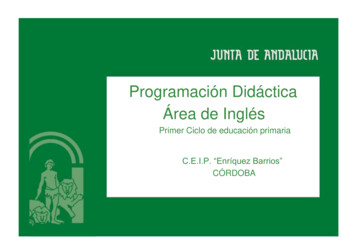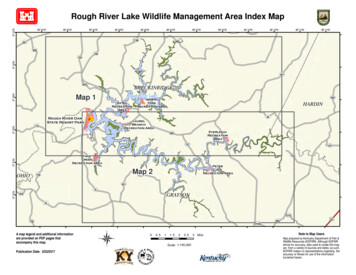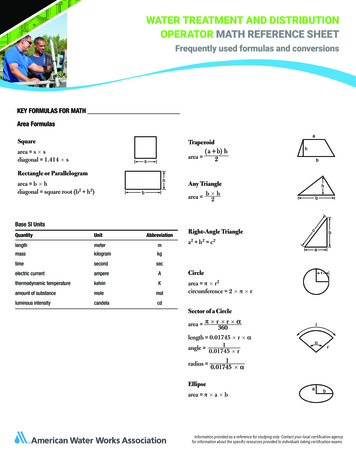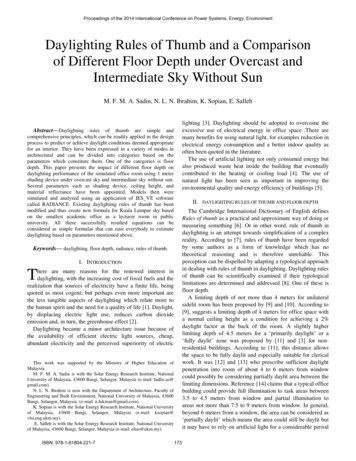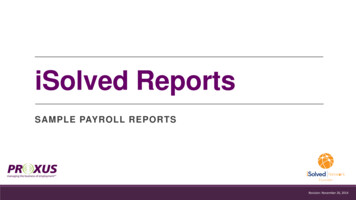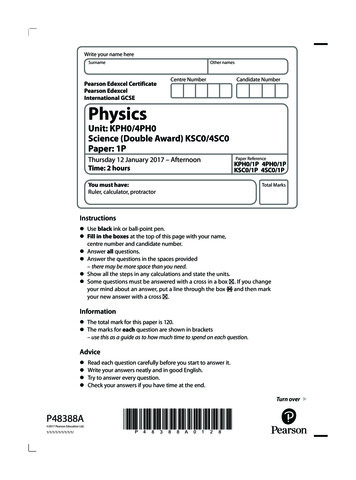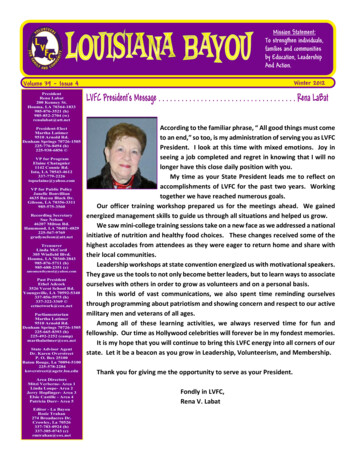
Transcription
A Summary of Johnsonburg Area School District’s2021 - 403(b) Tax Sheltered Account ProgramJohnsonburg Area School District offers our eligible employees the opportunity to save for retirement byparticipating in a 403(b) Tax- Sheltered Account (TSA) Plan. All employees, except for private contractors,appointed/elected trustees and/or school board members and student workers, are eligible to participate in the 403(b)Plan immediately upon employment. You can participate in this plan by making pre-tax contributions. The 403(b)TSA Plan is a valuable retirement savings option. This notice provides a brief explanation of the provisions, policiesand rules that govern the 403(b) TSA Plan offered.What is a 403(b) Tax-Sheltered Account?403(b) Tax-Sheltered Account (TSA) is a section of the IRS Code that permits the establishment of 403(b) TSAs forschool employees to supplement their retirement income. A 403(b) TSA allows you to voluntarily set aside moneyfrom each paycheck to be put into a tax-deferred account. It’s called an “elective deferral;” you notify the payrolloffice, that you wish (“elective”) to have funds taken out of your pay (“deferral”) and contributed to your 403(b)TSA. You may begin your contribution, change the amount of your contribution, or stop your contribution at anytime. The funds withheld from your paycheck are then invested with a 403(b) provider that you choose from our listof approved companies. You control how your funds are invested by consulting with a representative from theinvestment provider you select.How much can you contribute to your 403(b) TSA?The maximum amount you can contribute for the current calendar year is 19,500. Everyone can contribute up to 19,500 or 100% of salary if you make less than 19,500. Beginning on January 1 of the year you turn 50, you maycontribute an additional 6,500, each year. If you are able and desire to contribute more than the maximum, see ifthe district offers a 457(b) Deferred Compensation program. If a 457(b) Plan is available, you may be allowed tocontribute similar amounts to that tax-sheltered program.When can I get my money out of my 403(b) TSA?You may request a distribution when you retire, terminate your employment with the employer, or become disabled.Distributions prior to age 59 ½ may be subject to a 10% IRS tax penalty; however, if you separate service during orafter the calendar year in which you turn age 55 you may withdraw your funds without incurring an IRS penalty. Ifyou do not request a distribution, IRS regulations require that you begin distributions at age 72 or upon retirement, iflater. You should check with your investment provider representative to see if you are subject to any contractualwithdrawal fees from the investment program you have selected. In the event of your death, 100% of your accountbalance is payable to your designated beneficiary.Why should you participate in a 403(b) TSA program?First: It reduces your current income taxes. It is the first tax shelter that nearly every tax professional recommends.Second: It provides for tax-deferred growth. Instead of paying income taxes on your bank interest earnings, all yourcontributions, and the earnings on those contributions, are tax deferred until you take out the money. That will usually be afterretirement when you will most likely be in a lower tax bracket.Third: It supplements other retirement benefits, like your personal savings, Social Security, and the PA Public School EmployeesRetirement System (PSERS). Who knows if any of us will get all the Social Security we are entitled to, given the budget shortfallof Social Security and Medicare? And, even though PSERS is one of the best retirement systems, you still will have to live on theamount of that check from PSERS for the rest of your life. And many of today’s employees will live longer retired than theyworked. It is not uncommon for people to live to their late 80’s, 90’s or even 100. Considering future scientific and medicaladvances, that PSERS check may have to last you 30 years or more. You need to supplement it with your 403(b) TSA, whichshould reflect any economic growth during your career and retirement years.
Who is administering the district’s 403(b) TSA Program?The district has chosen TSA Consulting Group, Inc. as the Third-Party Administrator (TPA) because of theirexperience and reliability. They employ a full-service flexible technology platform that provides secure Internetaccess by both employers and employees. You can get immediate answers to your questions regarding allcontributions and transaction processing requests, as well as access all necessary forms on their websitewww.tsacg.com. (NOTE: The TPA charges no fees to employees. There may be fees associated with yourinvestment that your investment provider and/or investment fund may charge.)Optional Provisions Included in Johnsonburg Area School District’s 403(b) TSA PlanEligibilityAll employees, except for private contractors, appointed/elected trustees and/or school board members and studentworkers, are eligible to participate in the 403(b) Plan immediately upon employment. Employees may makevoluntary elective deferrals to the 403(b) TSA Plan. Participants are always fully vested in their contributions andearnings.ExchangesOur 403(b) TSA Plan does permit exchanges. An “exchange” is defined by the IRS as moving your 403(b) TSAfrom one of our approved investment providers to another of our approved investment providers. Under IRS 403(b)TSA regulations, you may only invest your 403(b) TSA funds with the district’s approved investment providers ifyou are employed by our district.TransfersOur 403(b) TSA Plan does permit transfers, both into our plan and out of our plan. A “transfer” is defined by theIRS as moving your 403(b) TSA from one employer’s 403(b) TSA Plan to another employer’s 403(b) TSA Planwhen you change employment. If you have a 403(b) TSA with a previous employer, and that employer’s 403(b)TSA Plan permits transfers out of their 403(b) TSA Plan, you may transfer the account with the previous employerto our 403(b) TSA Plan. However, you must transfer the account to one of our districts’ approved investmentproviders. If you leave employment with our district, you may transfer your account to a subsequent employer’s403(b) TSA (if that employer’s 403(b) TSA Plan allows for incoming transfers) or you may rollover your account(see below).RolloversAs required by IRS regulations, our 403(b) TSA Plan does permit rollovers. A “rollover” is defined by the IRS asmoving your 403(b) TSA upon the occurrence of a “distributable event” (age 59 ½, death, disability, separation fromservice, etc.). Once you leave employment with our district, (or upon another distributable event) you are permittedto rollover your 403(b) TSA to any other IRS permitted account, such as an IRA.LoansOur 403(b) TSA Plan does permit you to borrow funds from your 403(B) TSA; however, you need to check withyour investment provider to determine if your investment provider permits loans. Loans are subject to IRSregulations and prior to taking a loan, participants should consult a tax advisor.Financial Hardship DistributionsOur 403(b) TSA Plan does permit you to apply for a Hardship Distribution from your 403(B) TSA. HardshipDistributions are subject to IRS regulations and to be eligible for a hardship withdrawal according to IRS SafeHarbor regulations, you must verify and provide evidence that the distribution is being taken for specific reasons.
Roth 403(b)Our 403(b) TSA Plan does permit you to contribute to a Roth 403(b). Like a Roth IRA, Roth 403(b) contributionsdo not tax shelter current income; they are funded with after-tax dollars. One advantage of a Roth is the earningsgrow tax free; there are no taxes on withdrawals from a Roth 403(b) if all the Roth and 403(b) rules are followed.The maximum annual contribution for a Roth 403(b) is combined with the traditional 403(b) TSA: For the currentcalendar year, 19,500 and 6,500 for the age 50 catch-up. For example: if you are under 50 years of age, you couldcontribute 10,000 to a traditional 403(b) TSA and up to 9,500 to a Roth 403(b). Withdrawals of your contributionand earnings can be made tax free. (Reached age 59 ½ and Account has been held for at least five years) Contactone of the approved investment providers for more information about the Roth 403(b). Roth 403(b) contributions aresubject to IRS regulations.Authorized Investment Providers This 403(b) TSA PlanASPIRE FINANCIAL SERVICES (403(b) ASP)EQUITABLEHORACE MANN INSURANCE COKADES-MARGOLIS CORPORATIONMETLIFE INSURANCE CONEW YORK LIFE INS & ANNUITY CORPSECURITY BENEFIT GROUPTHE LEGEND GROUP/ ADSERVVANGUARD INVESTMENTSContactsPhoneN/AJerad RosendahSherman BloomCharles Scott NewmanCharles MeyerScott OlewineCharles Scott NewmanM. J. 2-5745800-662-2003
Salary Reduction Agreement for 403(b) ProgramsALL EMPLOYEES, WITHOUT EXCEPTION, ARE ELIGIBLE TO PARTICIPATE IN THE 403(B) PROGRAMSPart 1. Employee Information:Name: SS#:Address:Part 2. AgreementThe above named Employee elects to become a participant of the (Employer Name)403(b) and/or 457 Plan(s) and agrees to be bound by all the terms and conditions of the plan. By executing this agreementemployee authorizes the employer to reduce his or her compensation and have that amount contributed as an elective deferraland/or as a salary reduction contribution to the Roth 403(b) option if permitted in the plan, on his or her behalf into the annuity orcustodial accounts as selected by the employee. It is intended that the requirements of all applicable state or federal income taxrules and regulations (Applicable Law) will be met. The Employee understands and agrees to the following:1) this Salary Reduction Agreement is legally binding and irrevocable with respect to amounts paid or availablewhile this agreement is in effect.2) this Salary Reduction Agreement may be terminated at any time for amounts not yet paid or available, and that atermination request is permanent and remains in effect until a new Salary Reduction Agreement is submitted; and3) this Salary Reduction Agreement may be changed with respect to amounts not yet paid or available in accordancewith the Employer’s administrative procedures4) the Employer will stop reductions at such time as the reduction will exceed the Employee’s statutory limits underSection 402(g) or the limitation of Section 415 of the Internal Revenue Code in any given calendar year.Employee is responsible for providing the necessary information at the time of initial enrollment and later if there are anychanges in any information necessary or advisable for the employer to administer the plan. Employee is responsible fordetermining that the salary reduction amount does not exceed the limits set forth in applicable law and for selecting annuities orcustodial accounts. Furthermore, Employee agrees to indemnify and hold Employer harmless against any and all actions, claimsand demands whatsoever that may arise from the purchase of annuities or custodial accounts. Employee acknowledges thatEmployer has made no representation to Employee regarding the advisability, appropriateness, or tax consequences of thepurchase of the annuity and/or custodial account described herein. Employee agrees Employer shall have no liability whatsoeverfor any and all losses suffered by Employee with regard to his/her selection of the annuity and/or custodial account. Nothingherein shall affect the terms of employment between Employer and Employee. This agreement supersedes all prior salaryreduction agreements and shall automatically terminate if Employee’s employment is terminated.Employee is responsible for setting up and signing the legal documents to establish an annuity contract or custodial account.However, in certain group annuity contracts, the Employer is required to establish the contract.Employee is responsible for naming a death beneficiary under annuity contracts or custodial accounts. Employee acknowledgesthat this is normally done at the time the contract or account is established and reviewed periodically.Employee is responsible for all distributions and any other transactions with vendor. All rights under contracts or accounts areenforceable solely by Employee, Employee beneficiary or Employee’s authorized representative. Employee must deal directlywith the vendor to make loans, transfers, apply for hardship distributions, begin regular distributions, or any other transactions.Part 3. Representation by Employee for Calendar Year :A.Participation in other employer plans: (you must check only one)I do not and will not have any other elective deferrals, voluntary salary reduction contributions, or nonelective contributions with any other employer.I do participate in another employer’s 403(b), 401(k), SIMPLE IRA/401(k), or Salary Reduction SEP. Thefollowing information pertains to all of my other employers for the current calendar year: IncludibleEarnings ; Elective Deferrals and/or salary reduction contributions to a Roth 403(b) or Roth401(k) plan ; Non-elective Contributions .
B.I have not received a Hardship Distribution from a plan of this Employer within the last six months. I further agree toprovide notification to the employer prior to initiating a request if I plan to elect a hardship distribution during the termof this agreement.C.Maximum Elective Deferral or Roth 401(k)/403(b)/457(b) salary reduction contribution: (you must check only one)My elective deferral/salary reduction contribution does not exceed the Basic Limit (the lesser of myincludible compensation or 19,500).My elective deferral exceeds the Basic Limit due to the additional Age 50 Catch-up of 6,500.Part 4. Voluntary Salary Reduction Information: (Check all that apply)Initiate new salary reductionPlease complete Part 5.Change salary reductionThis is notification to change the amount of my elective deferralto the new amount listed in Part 5.Change Funding Vehicle VendorThis is notification to change my Funding Vehicle – Complete Part 5.Discontinue salary reductionPlease discontinue my elective deferral to the following Funding Vehicle:.Implementation Date (next available pay on or after): .Part 5. Funding Vehicle & Amount of Pre-Tax Elective Deferrals:1.Contribution Per Pay Period(select one) * % or 2. % or 3. % or Funding Vehicles (Annuity Contracts or Custodial Accounts)Part 5a. Funding Vehicle & Amount of After-Tax Salary Reduction Contributions to the Roth 403(b):1.Amount Per Pay(select one) * % or 2. % or 3. % or Funding Vehicles (Annuity Contracts or Custodial Accounts)* NOTE: Any employee who works variable hours or who does not have a regular bi-weekly paycheck must select “% of pay.”
Part 6. Employee SignatureI certify that I have read this complete agreement and provided the information necessary for the employer to administer the planand that my salary reductions will not exceed the elective deferral or contribution limits as determined by Applicable Law. Iunderstand my responsibilities as an Employee under this Program, and I request that Employer take the action specified in thisagreement. I understand that all rights under the annuity or custodial account established by me under the Program areenforceable solely by my beneficiary, my authorized representative or me.I understand that certain information about my 403(b) account is necessary to properly maintain and administer my account underthe 403(b) plan. I authorize the holder of that information to make it available to the plan sponsor, the administrator of the planand/or their representative(s) so long as the information is used exclusively for purposes of complying with legal and regulatoryrequirements and proper administration of the plan and my account there under.I am aware that if I select Vanguard Funds as my investment provider, plan administration expenses will be deductedfrom my account on a monthly basis. This fee, 24.00 annually, may be changed in the future subject to prior notificationto me of such change.Employee Signature:Date:Part 7. Representative SignatureSignature: Company Name: Date:Part 8. Employer SignatureEmployer hereby agrees to this Salary Reduction Agreement:Employer Signature: Title: Date:Prepared by:
Roth 403(b) Our 403(b) TSA Plan does permit you to contribute to a Roth 403(b). Like a Roth IRA, Roth 403(b) contributions do not tax shelter current income; they are funded with after-tax dollars.

